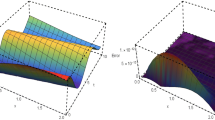We consider a mathematical model of propagation of drugs in the wall of a vessel. The model is described by the advection-diffusion boundary-value problem with a system of two differential equations. In view of the specific features of the input parameters of the problem, when the advection coefficient significantly exceeds the diffusion coefficient, the application of the classical finite-element method with linear and quadratic basis functions leads to the loss of stability of the computational process. We propose a new approach to the solution of the advection-diffusion problems with large Péclet numbers based on the replacement of the unknown function by an exponential function in the formulation of the problem and the inverse replacement prior to the application of the finite-element method. We also perform the numerical analysis of the results obtained by the application of the proposed method for the approximate solution of the problem of propagation of drugs in the wall of a vessel.
Similar content being viewed by others
References
É. M. Kartashov, Analytic Methods in the Theory of Heat Conduction of Solids [in Russian], Vysshaya Shkola, Moscow (1985).
Ya. G. Savula, Numerical Analysis of the Problems of Mathematical Physics by Variational Methods [in Ukrainian], Lviv National University, Lviv (2004).
Ya. Savula, Yu. Turchyn, and N. Kit, “Computer simulation of the process of transfer of drugs in living tissues,” Visn. Lviv. Univ. Ser. Prykl. Mat. Inform., Issue 19, 93–98 (2013).
Yu. Turchyn, “Exponential change in the finite-element method for the advection-diffusion equations,” Fiz.-Mat. Model. Inform. Tekhnol., Issue 24, 111–117 (2016).
C. D’Angelo, L. Formaggia, S. Minisini, C. Vergara, and P. Zunino, “Mathematical models and numerical simulation of drug release in the vascular system,” in: Workshop IV: Optimal Transport in the Human Body — Lungs and Blood, UCLA–IPAM (2008).
F. Hecht, O. Pironneau, A. Le Hyaric, and K. Ohtsuka, FreeFEM++ Version 2.9 CiteSeerX, Lab. Jacques-Louis Lions, Paris (2012). http://www.freefem.org/ff++.
S. S. Hossain, S. F. A. Hossainy, Y. Bazilevs, V. M. Calo, and T. J. R. Hughes, “Mathematical modeling of coupled drug and drugencapsulated nanoparticle transport in patient-specific coronary artery walls,” Comput. Mech., 49, No. 2, 213–242 (2012). https://doi.org/10.1007/s00466-011-0633-2.
F. Hussain and M. S. Karim, “Accurate evaluation schemes for triangular domain integrals,” IOSR. J. Mech. Civil Eng., 2, No. 6, 38–51 (2012). https://doi.org/10.9790/1684-0263851.
Author information
Authors and Affiliations
Corresponding author
Additional information
Translated from Matematychni Metody ta Fizyko-Mekhanichni Polya, Vol. 61, No. 2, pp. 150–158, April–June, 2018.
Rights and permissions
About this article
Cite this article
Savula, Y.H., Turchyn, Y.I. One Approach to the Numerical Solution of Mass-Transfer Problems with Large Péclet Numbers. J Math Sci 253, 168–179 (2021). https://doi.org/10.1007/s10958-021-05221-9
Received:
Published:
Issue Date:
DOI: https://doi.org/10.1007/s10958-021-05221-9




